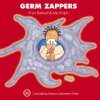![Germ Zappers Germ Zappers]()
Click to have a closer look
About this book
Customer reviews
Related titles
About this book
Planet Earth can be a dangerous place for all living creatures, including you. You can usually escape from erupting volcanoes and floods. You can protect your body from the blazing sun and freezing snow. But wherever you live and whatever the weather, you cannot escape germs. The Enjoy Your Cells series offers children a simple but scientifically accurate commentary, complemented with colourful graphics to take young readers on an entertaining exploration of the amazing, hidden world of cells, proteins, and DNA. With these books, children should learn to enjoy their cells and current affairs at the same time, in addition to getting information that has been written and reviewed by working scientists.
Age Level: 5 to 10 years
Customer Reviews
By: Fran Balkwill(Author), Mic Rolph(Illustrator)
32 pages, colour illustrations
"Parents wearied by the bizarre exploits of Metal Greymon, Goku or Bubbles (don't ask) might try presenting their embattled child with Germ Zappers. This nifty little book is in Cold Spring Harbor Laboratory Press's Enjoy Your Cells series. It showcases home-grown heroes – the cells of the immune system.
It's presented with brilliant simplicity: the drawings are accurate, the text is a doddle to understand. Nor can you lose with plot lines like these – murder by squashing, macrophages as super rubbish collectors, neutrophils engaged on spy-like "deadly missions". It is full of inspired touches such as "Top of the Pox", a parade of all the usual viral suspects that has warts rubbing shoulders with diarrhoea.
Joshua, six-and-a-half, read it with relish. "A germ," he told me afterwards, "is a small thing that has quite a lot of power, really, and could make you very, very sick. Germs are bacteria or viruses. Cells in our body can kill them. There's a special sort of cell in your belly that makes acid and destroys anything suspicious like a germ. I also thought the natural killer cell was powerful and cool. It's funny-looking–ball-shaped with bumps – and it sneaks up and sticks holes in the membrane of an infected cell."
See? Germ Zappers is every bit as weird as Dragon Ball Z–and there's no merchandise attached to it. Go for it."
– New Scientist







































